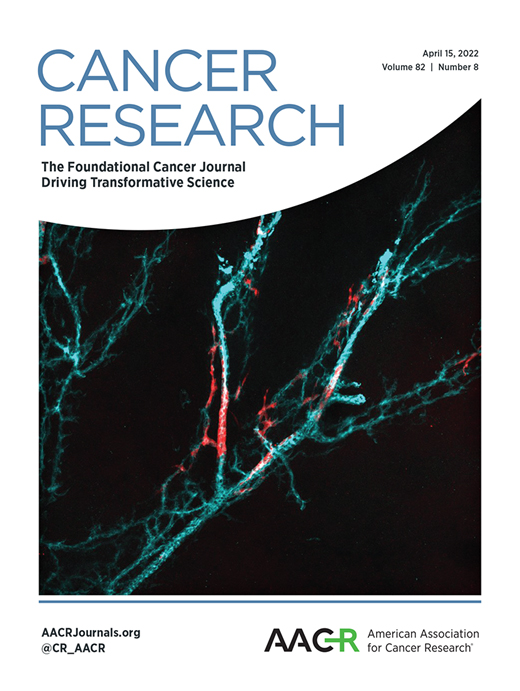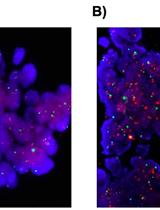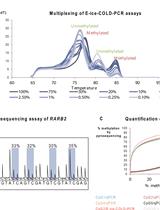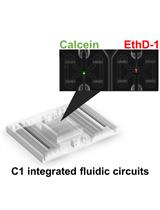- EN - English
- CN - 中文
In-Cell Western Protocol for Semi-High-Throughput Screening of Single Clones
单克隆半高通量筛选的In-Cell Western实验方案
(*contributed equally to this work) 发布: 2022年08月20日第12卷第16期 DOI: 10.21769/BioProtoc.4489 浏览次数: 3344
评审: Chiara AmbrogioJohn W PetersonAnonymous reviewer(s)
Abstract
The in-cell western (ICW) is an immunocytochemical technique that has been used to screen for effects of siRNAs, drugs, and small molecule inhibitors. The reduced time and number of cells required to follow this protocol illustrates its semi-high-throughput nature. Performing a successful ICW protocol requires fixing and permeabilizing adherent cells directly in the plate that specifically exposes the epitope of interest. After blocking of non-specific proteins, the cells are incubated overnight with a primary antibody of interest, which is detected via a host-specific near-infrared fluorescently labeled LI-COR secondary antibody. In the final step, the plate is scanned using an Odyssey LI-COR Imaging System or similar, and each of the wells is quantified. For the first time, this technique has been demonstrated to be reproducibly utilized for semi-high-throughput selection of knockout or overexpression clones.
Graphical abstract:

Background
Knockout or overexpression screens are efficient methods for identifying the involvement of novel genes that contribute to phenotypes such as drug resistance. Perturbation of gene function is enabled through either loss-of-function studies, using biological tools such as the CRISPR-Cas9 system (Clustered Regularly Interspaced Short Palindromic Repeats) (Humphrey and Kasinski, 2015; Szlachta et al., 2018; Li and Kasinski, 2020), or by gain-of-function studies through overexpression of human ORFs (Open Reading Frame) (Arnoldo et al., 2014). Several genes can potentially be identified by such screening methodologies; however, validation is a key step. To validate and dissect the cellular function of the gene(s) of interest, gene modulation has become a prevalent technique in the field. To this end, the candidate gene is either individually knocked out or overexpressed, single clones are isolated, and finally the phenotype observed via the screen is reevaluated. Nevertheless, to confirm that the gene of interest is accurately knocked out or overexpressed in single clones, protein quantification is a usual process.
Differential protein expression of individual clones is conventionally determined by western blot. This and other techniques such as immunofluorescence and immunohistochemistry are indispensable methods for protein analysis; however, these protocols require increased amounts of resources (antibodies, reagents) and often need one or more days to complete. Therefore, a semi-high-throughput screen that allows for rapid identification of differential protein expression post-clonal selection that reduces expenses, labor, and time should be considered. The in-cell western (ICW) is a powerful, simple, and reproducible technique that is underutilized in the field. It is a cost-effective method to quantify intracellular signaling in intact cells. The ICW protocol involves fixation and immunostaining of cells and combines the specificity of a western blot with the reproducibility and throughput of an enzyme-linked immunosorbent assay (ELISA) (Boveia and Schutz-Geschwender, 2015). From previous reports, semi-high-throughput cell-based applications of ICW include: 1) identification of efficient siRNAs from libraries and 2) identification of small molecule inhibitors targeting a particular signaling pathway (Hoffman et al., 2010). Additionally, ICW has been successfully utilized for screening genotoxic drugs by quantifying the expression of γH2AX, a well-known DNA damage and repair marker (Khoury et al., 2013). Another example of the versatility of ICW for throughput experiments is during the screening of chemical libraries for compounds that modulate the intensity and duration of growth factor-induced MAPK activity, an important regulator in cancer progression (Schnaiter et al., 2014).
Here, we describe a semi-high-throughput screening mechanism using the ICW protocol for validation of single knockout or overexpression clones for a protein of interest, initially identified using the CRISPR-Cas9 screening system (Pal et al., 2020, 2022). ICW has proved to be an efficient technique for clonal selection of cells because it allows rapid analysis of numerous samples, conserving the accuracy of the quantifiable output. To the best of our knowledge, the ICW protocol described below is the first reported use of ICW for the selection of multiple single clones simultaneously.
The pros and cons of using ICW versus western blot for efficient clonal selection of cells are enlisted below (Table 1).
Table 1. Pros and cons of using in-cell western over using the more conventional technique of western blot for high-throughput selection of single clones.
| Pros | Cons |
|
|
The protocol described here is validated for one protein; therefore, optimization of various parameters may be necessary to achieve study-specific goals, described in Table 2.
Table 2. Parameters at specific steps of ICW that can be optimized to achieve high-throughput selection of single clones for study-specific goals.
| Steps in protocol | Parameters to be optimized |
| Antibody Optimization |
|
| Cells |
|
| Choice of plate |
|
| Fixation |
|
| Permeabilization |
|
Materials and Reagents
96-well clear flat-bottom polystyrene tissue-culture plates (Corning, catalog number: 3596)
15 mL Falcon tubes (Corning, Falcon®, catalog number: 352097)
Reagent reservoir nonsterile (VWR, catalog number: 89094-684)
100% methanol (Thermo Fisher, catalog number: A412-20), storage: room temperature
Distilled water, storage: room temperature
NaCl (Sigma Aldrich, catalog number: S3014-1KG), storage: room temperature
KCl (Sigma Aldrich, catalog number: P9333-1KG), storage: room temperature
KH2PO4 (Sigma Aldrich, catalog number: P9791-500G), storage: room temperature
Na2HPO4·2H2O (Sigma Aldrich, catalog number: 71643-1KG), storage: room temperature
Triton X (Sigma Aldrich, catalog number: X100), storage: room temperature
Tween-20 (Sigma Aldrich, catalog number: P9416), storage: room temperature
Primary Antibodies (varies), storage: either 4 °C or -20 °C, depending on the antibody
LI-COR Secondary Antibodies (varies), storage: 4 °C
1× PBS (see Recipes)
Permeabilizing buffer (0.2% Triton X in 1× PBS) (see Recipes)
1× Phosphate Buffered Saline Tween-20 (PBST) (see Recipes)
Equipment
LI-COR Blocking Buffer (LI-COR, Odyssey, catalog number: 927-40003)
Multichannel pipettes (Mettler-Toledo International, catalog number: L12-200XLS)
FinnpipetteTM Novus multichannel pipette (Thermo Fisher Scientific, Thermo ScientificTM, catalog number: 46300800)
Software
Image Studio Lite (LI-COR Biosciences, https://www.licor.com/bio/image-studio/)
Procedure
文章信息
版权信息
© 2022 The Authors; exclusive licensee Bio-protocol LLC.
如何引用
Pal, A. S., Agredo Montealegre, A. and Kasinski, A. L. (2022). In-Cell Western Protocol for Semi-High-Throughput Screening of Single Clones. Bio-protocol 12(16): e4489. DOI: 10.21769/BioProtoc.4489.
分类
癌症生物学 > 通用技术 > 分子生物学技术
癌症生物学 > 通用技术 > 遗传学 > 基因表达
分子生物学 > 蛋白质 > 检测
您对这篇实验方法有问题吗?
在此处发布您的问题,我们将邀请本文作者来回答。同时,我们会将您的问题发布到Bio-protocol Exchange,以便寻求社区成员的帮助。
提问指南
+ 问题描述
写下详细的问题描述,包括所有有助于他人回答您问题的信息(例如实验过程、条件和相关图像等)。
Share
Bluesky
X
Copy link












